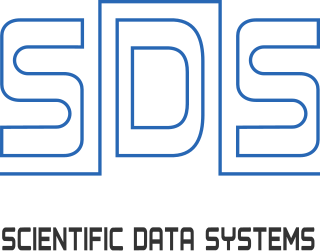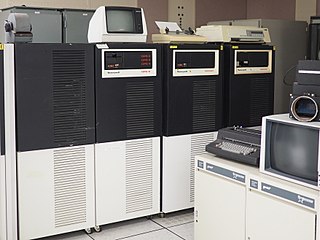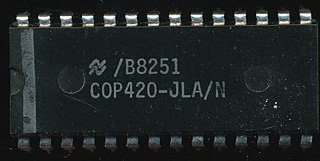The control unit (CU) is a component of a computer's central processing unit (CPU) that directs the operation of the processor. A CU typically uses a binary decoder to convert coded instructions into timing and control signals that direct the operation of the other units.

The Data General Nova is a series of 16-bit minicomputers released by the American company Data General. The Nova family was very popular in the 1970s and ultimately sold tens of thousands of units.
In processor design, microcode serves as an intermediary layer situated between the central processing unit (CPU) hardware and the programmer-visible instruction set architecture of a computer, also known as its machine code. It consists of a set of hardware-level instructions that implement the higher-level machine code instructions or control internal finite-state machine sequencing in many digital processing components. While microcode is utilized in general-purpose CPUs in contemporary desktops, it also functions as a fallback path for scenarios that the faster hardwired control unit is unable to manage.

Digital Equipment Corporation (DEC)'s PDP-10, later marketed as the DECsystem-10, is a mainframe computer family manufactured beginning in 1966 and discontinued in 1983. 1970s models and beyond were marketed under the DECsystem-10 name, especially as the TOPS-10 operating system became widely used.
The NS32000, sometimes known as the 32k, is a series of microprocessors produced by National Semiconductor. The first member of the family came to market in 1982, briefly known as the 16032 before becoming the 32016. It was the first general-purpose microprocessor on the market that used 32-bit data throughout: the Motorola 68000 used 32-bit data but had a 16-bit ALU and thus took twice as long perform many operations. However, the 32016 contained many bugs and often could not be run at its rated speed. These problems, and the presence of the otherwise similar 68000 which had been available since 1980, led to little use in the market.
The Honeywell 6000 series computers were rebadged versions of General Electric's 600-series mainframes manufactured by Honeywell International, Inc. from 1970 to 1989. Honeywell acquired the line when it purchased GE's computer division in 1970 and continued to develop them under a variety of names for many years. In 1989, Honeywell sold its computer division to the French company Groupe Bull who continued to market compatible machines.

The HP 2100 is a series of 16-bit minicomputers that were produced by Hewlett-Packard (HP) from the mid-1960s to early 1990s. Tens of thousands of machines in the series were sold over its twenty-five year lifetime, making HP the fourth largest minicomputer vendor during the 1970s.

Scientific Data Systems (SDS), was an American computer company founded in September 1961 by Max Palevsky, Arthur Rock and Robert Beck, veterans of Packard Bell Corporation and Bendix, along with eleven other computer scientists. SDS was the first to employ silicon transistors, and was an early adopter of integrated circuits in computer design. The company concentrated on larger scientific workload focused machines and sold many machines to NASA during the Space Race. Most machines were both fast and relatively low priced. The company was sold to Xerox in 1969, but dwindling sales due to the oil crisis of 1973–74 caused Xerox to close the division in 1975 at a loss of hundreds of millions of dollars. During the Xerox years the company was officially Xerox Data Systems (XDS), whose machines were the Xerox 500 series.
The Nord-100 was a 16-bit minicomputer series made by Norsk Data, introduced in 1979. It shipped with the Sintran III operating system, and the architecture was based on, and backward compatible with, the Nord-10 line.
The SDS 940 was Scientific Data Systems' (SDS) first machine designed to directly support time-sharing. The 940 was based on the SDS 930's 24-bit CPU, with additional circuitry to provide protected memory and virtual memory.

The SDS Sigma series is a series of third generation computers that were introduced by Scientific Data Systems of the United States in 1966. The first machines in the series are the 16-bit Sigma 2 and the 32-bit Sigma 7; the Sigma 7 was the first 32-bit computer released by SDS. At the time, the only competition for the Sigma 7 was the IBM 360.

LINC-8 is the name of a minicomputer manufactured by Digital Equipment Corporation between 1966 and 1969. It combines a LINC computer with a PDP-8 in one cabinet, thus being able to run programs written for either of the two architectures.
The Bendix G-20 computer was introduced in 1961 by the Bendix Corporation, Computer Division, Los Angeles, California. The G-20 followed the highly successful G-15 vacuum-tube computer. Bendix sold its computer division to Control Data Corporation in 1963, effectively terminating the G-20.
The IBM System/360 architecture is the model independent architecture for the entire S/360 line of mainframe computers, including but not limited to the instruction set architecture. The elements of the architecture are documented in the IBM System/360 Principles of Operation and the IBM System/360 I/O Interface Channel to Control Unit Original Equipment Manufacturers' Information manuals.

The IBM System/360 Model 44 is a specialized member of the IBM System/360 family, with a variant of the System/360 computer architecture, designed for scientific computing, real-time computing, process control and numerical control (NC).

The Honeywell Level 6 was a line of 16-bit minicomputers, later upgraded to 32-bit, manufactured by Honeywell, Inc. from the mid 1970s. Honeywell literature for Models 6/06, 6/34 and 6/36 say "Series 60 ". In 1979 the Level 6 was renamed the DPS 6, subsequently DPS 6 Plus and finally DPS 6000.
The Xerox 500 series is a discontinued line of computers from Xerox Data Systems (XDS) introduced in the early 1970s as backward-compatible upgrades for the Sigma series machines.
CP-6 is a discontinued computer operating system, developed by Honeywell, Inc. in 1976, which was a backward-compatible work-alike of the Xerox CP-V, fully rewritten for Honeywell Level/66 hardware. CP-6 was a command line oriented system. A terminal emulator allowed use of PCs as CP-6 terminals.
The AN/AYK-14(V) is a family of computers for use in military weapons systems. It is a general-purpose 16-bit microprogrammed computer, intended for airborne vehicles and missions. Its modular design provides for common firmware and support software. It is still in use on Navy fleet aircraft including the F/A-18, and the AV-8B. The AN/AYK-14(V) family of systems is designed to meet MIL-E-5400 (airborne) requirements.

The COP400 or COP II is a 4-bit microcontroller family introduced in 1977 by National Semiconductor as a follow-on product to their original PMOS COP microcontroller. COP400 family members are complete microcomputers containing internal timing, logic, ROM, RAM, and I/O necessary to implement dedicated controllers. Some COP400 devices were second-sourced by Western Digital as the WD4200 family. In the Soviet Union several COP400 microcontrollers were manufactured as the 1820 series.










